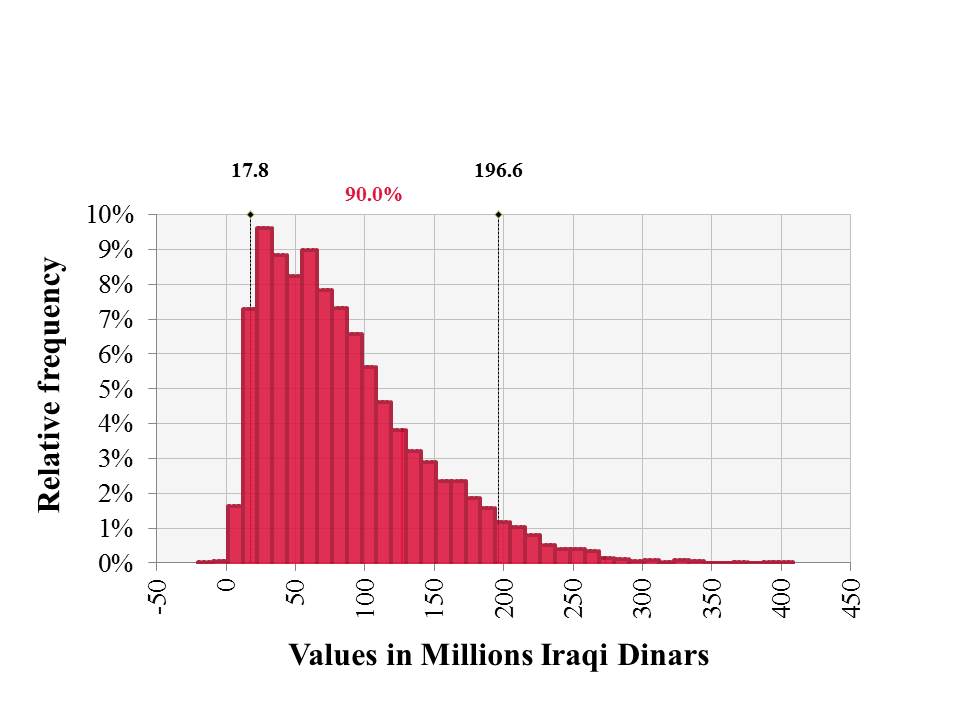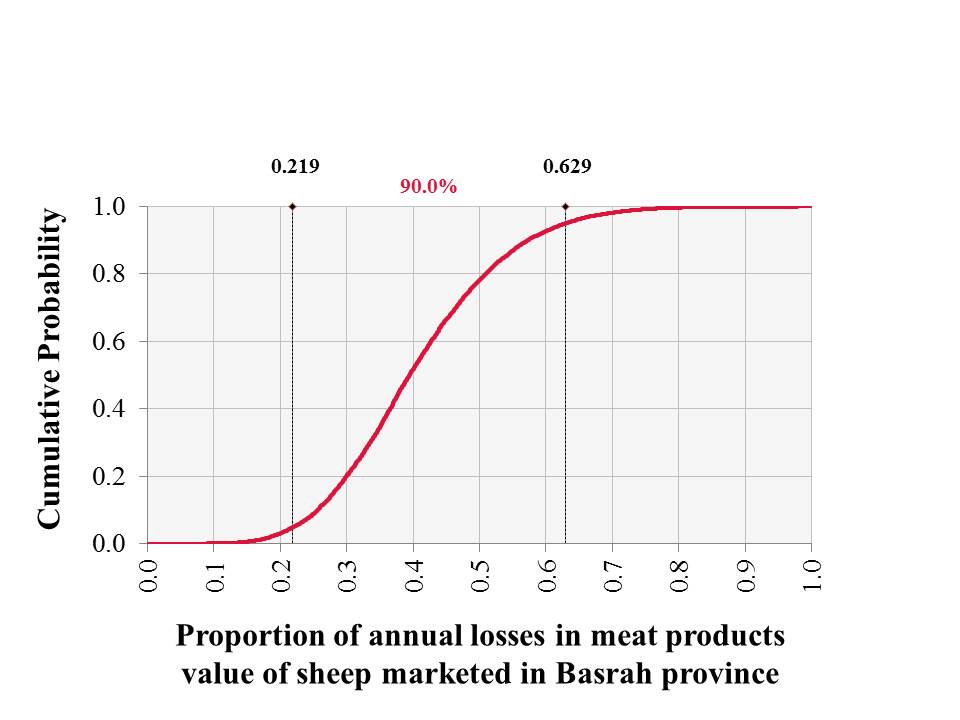
Background
Cystic echinococcosis (CE) is an important parasitic infection impacting both animal and public health, notably throughout the Middle East and North Africa. CE is caused by Echinococcus granulosus. Livestock can acquire the infection indirectly from grass and water contaminated by the eggs of E. granulosus. Humans can become infected with CE accidently by ingesting the eggs of Echinococcus through contaminated food and water. CE in humans is most commonly found in rural communities and among people involved in raising sheep due to the sheep's role as a host of the parasite. Worldwide, experts estimate more than 1 million people live with CE at any one time. Many of these people experience severe clinical syndromes that are life-threatening if left untreated.
In Iraq, the small ruminant sector is very important for sustaining the country's food security. There are presently an estimated 7–8 million sheep in Iraq contributing a valuable source of meat, and providing income and job security to people working across the agricultural sector.
CE infections in sheep pose an economic cost to Iraqis working in agriculture, however, the exact cost was unknown. The economic cost of CE in livestock are divided into direct costs (mainly the loss of revenue through the condemnation of offal) and indirect costs (reduced growth, fecundity and milk production of infected animals).
Previously, accurate estimates of economic losses due to CE are hampered by poor record keeping and reporting, as well as the fact that many informal butcheries exist in Iraq, where freshly-slaughtered meat are sold without any kind of meat inspection.
Dr. Ihab Habib, Lecturer in Veterinary Public Health and Food Safety Epidemiology at Murdoch University, along with his colleagues at the University of Basrah in Iraq and Huazhong Agricultural University in China collaborated to find the true economic cost of CE infections in the agricultural industry in Basrah.
Creating a Detailed Estimation
To create a better estimate of the direct economic costs of CE, the team conducted a cross-sectional survey at the local abattoir to determine the prevalence, organ distribution, viability and economic implications of hydatid cysts in the slaughtered sheep.
During the abattoir visits, the researchers noticed that hydatidosis were recorded in the abattoir daily inspection reports only if there was a severe case of profuse (multiple cysts) organ infestation that lead to “total organ condemnation.” Localized cysts were typically trimmed off the affected offal and then the organs and carcasses were collected by the attending butcher. After removal of these localized cysts the remaining organ entered the domestic market; however no record of these events were included in the daily abattoir inspection reports.
Turning into a Probabilistic Model
This inaccurate recording system led the team to develop a probabilistic model based on the results from the active abattoir survey (as described above), combined with expert-opinions of local veterinarians and butchers working in Basrah.
“The objective of our model was to estimate the direct economic loss form the condemnation of livers and lungs of the slaughtered sheep,” says Habib. “The model scope was to cover both formal and informal meat markets, as a sizable proportion of animals are slaughtered without official abattoir inspection by informal butcheries.”
The model was run with Iraqi Dinars and focused on losses arising from partial or total condemnation of livers and lungs, which are economically more valuable than other visceral organs, and also were found to have high hydatid infestation.
Using @RISK
To create this probabilistic model, the team turned to @RISK. They incorporated uncertainty and variability of the economic variables by using probability distributions of numerous parameters, which included:
- Probability of having sheep slaughtered at abattoir (with official meat inspection)
- Number of sheep slaughtered per annum at abattoir
- Probability of having sheep slaughtered elsewhere than the abattoir (without official meat inspection)
- Number of sheep slaughtered per annum elsewhere from abattoir
- Probability of having hydatid cyst in lung of a slaughtered sheep
- Estimate of the full value of a healthy sheep (carcass and offal) marketed in Basrah
- Retail price of a sheep lung sold at local market
- Probable percentage of decline in the retail price of a trimmed lung due to hydatid cyst
- Estimated retail price of a trimmed (downgraded) whole sheep lung due to hydatid cyst
- Probability of having hydatid cysts in the liver of a slaughtered sheep
- Retail price of a sheep liver sold at local market
- Probable percentage of decline in the retail price of a trimmed liver due to hydatid cysts
- Estimated retail price of a trimmed (downgraded) whole sheep liver due to hydatid cysts
- Total estimated annual cost due to hydatid cysts in the lungs and liver of a slaughtered sheep
- Estimated annual meat products value of sheep marketed in Basrah province
- Proportion of annual losses in meat products value of sheep marketed in Basrah province
Model Inputs and Sources of Data
Habib and his team had four sources of inputs for the model:
a) Retrospective abattoir data: number of sheep slaughtered at Basrah abattoir (official records only available between 2008-2015)
b) Active abattoir survey data - completed during the study (results from inspection of 631 slaughtered sheep)
c) Expert opinions of the local meat hygiene veterinarians: (interviews with six meat hygiene veterinarians working in meat control at the abattoir and markets of Basrah.)
d) Expert opinions of local butchers: (23 butchers attending the Basrah abattoir were interviewed for their input of the market price (namely minimum, most likely, and maximum) of liver and lungs.
Model Assumptions
The research team considered the following underlying assumptions while conceptualizing their model-based estimation:
a) The prevalence of hydatid cysts in the lungs and liver of sheep slaughtered at informal markets was same to that observed in the sheep slaughtered at Basrah abattoir.
b) Local butchers at the informal markets will trim off any visible hydatid cyst from the liver or lungs before selling it to the consumer.
The team ran the @RISK model for 50,000 iterations. They also conducted a sensitivity analysis using a stepwise linear regression of the estimated costs against the input parameter values, to assess the impact of each input parameter on the overall cost estimate.
Dr. Ihab Habib
Lecturer in Veterinary Public Health and Food Safety Epidemiology at Murdoch University
Results
Results of meat inspection in the abattoir survey indicated that 7.3% of the examined 631 sheep carcasses had one or more hydatid cysts. The majority of the cysts were located in the livers and lungs, with only one cyst detected outside these organs in the spleen. Hydatid cysts were concurrently present in the livers and lungs of more than half (54.3% (25/46)) of the positive sheep. In total, 37.1% (98/264) of the liver and lung cysts examined were viable.
“The probability distribution describing the aggregated expert opinions of the six veterinarians working in meat hygiene and inspection indicated that on average only 11% of the total sheep in Basrah are slaughtered at the certified abattoir (with official meat inspection),” says Habib. “Hence, the majority of sheep meat and offal in Basrah come from carcasses of animals slaughtered informally out of the abattoir.”
The average simulated number of sheep slaughtered elsewhere from abattoir in Basrah was estimated at 103,026 per year. The monetary value of the results was calculated at an exchange rate of 100,000 Iraqi Dinars = US$85.30. Based on the aggregated opinions of the 23 local butchers, the simulated retail market price of the liver and lungs was estimated at an average of US $12.70 (or 14,881 Iraqi Dinars) per sheep.
The model estimated that the average retail price of a trimmed whole sheep liver or lung due to the presence of hydatid cysts is US $4.50 (=5,286 Iraqi Dinars). The model estimated that the annual economic losses (considering both formal and informal markets) associated with hydatid cysts in the livers and lungs of sheep lost/condemned in Basrah to be an average of US $72,470 (=84,948,104 Iraqi Dinars; (Fig. 1.A).
The mean proportion of this monetary value of losses due to hydatid cysts in the livers and lungs was estimated as 0.42% of the annual sheep product value in Basrah province (Fig. 1.B). The model showed that the input variable on the probability of having sheep slaughtered at the official abattoir became most important in determining the overall costs, because there is a higher chance of meat being labeled as unfit for sale. The regression estimate for this variable (having sheep slaughtered at the official abattoir) resulted in a negative coefficient value (−0.61), indicating that this input variable has a negative impact; thus, increasing this input will decrease the output uncertainty.


Fig. 1. Monte Carlo simulation output representing; [A] the distribution of the estimated annual direct losses, and [B] the proportion of annual losses in meat products value due to hydatid cysts in livers and lungs of sheep marketed at Basrah province.

Fig. 2. Tornado chart shows univariate sensitivity analysis of contributions to output uncertainty by various model inputs. Estimated normalized regression coefficients showing the association between uncertain parameters and total estimated annual direct economic losses due to hydatid cysts in livers and lungs of sheep marketed at Basrah, south of Iraq.
“The results of the present study indicate that hydatid disease is relatively prevalent—as high as 7.3%--in sheep in Basrah,” says Habib. “Our results signify the importance of sheep as an intermediate host of E. granulosus and the potential important role they play in the transmission of the parasite in the southern region of Iraq.”
“This is the first study to produce a comprehensive estimate of the annual direct economic burden of CE in a livestock sector in the Iraqi setting,” Habib continues. “The Monte-Carlo simulation estimated an average annual direct economic loss of US $72,470.93 due to the visible hydatid cysts in livers and lungs of sheep marketed for human consumption in Basrah,” says Habib. “The results of this study demonstrate that CE is frequently prevalent and represents an important economic problem in the Basrah province, of Iraq.” Habib notes that stakeholders and policymakers can use these data to better allocate resources for combatting CE in this endemic region.
For Habib, @RISK was instrumental in assessing the extent of the economic cost of CE. Additionally, he notes it is a vital tool in education. “I find @RISK as one of the best educational tools for teaching probabilistic risk assessment, and its user friendly interface helps teaching complex concepts to students and trainees from a wide range of backgrounds. @RISK is a powerful, sophisticated, yet very flexible software. In our veterinary public health research, we rely a lot on @RISK to study biological risks at the human-animal interface” he says.
